work is a useful tool for organizing thoughts
Maneuver graphics and fire plan.
and formulating questions. Table 5-1, page
5-12, provides a checklist of some consider-Obstacle execution matrix/matrices.
ations for use during coordination between
Scheme-of-obstacle overlay.
the emplacing engineer and the company
Fire-support plan.
team commander. These considerations are
organized using the BOSs to provide a logi-
CSS graphics.
cal framework.
5-10 Obstacle Planning at Task-Force Level and Below

FM 90-7
SITING THE OBSTACLE
mass fires and marks the necessary fire-
The emplacing engineer and the company
control measures on the ground. The loca-
team commander site individual obstacles to
tion of these control measures must be clear
achieve synchronization between the obsta-
since they are the basis for obstacle siting.
cle effect and fires. Both must devote suffi-
Second, the commander identifies tentative
cient time to the siting effort, since it represents locations for his key weapons within his
the final adjustments to obstacle location
position or sector. Finally, he and the engi-
and fire control before emplacement.
neer must both understand the intent of the
obstacle group.
To site individual obstacles, certain precon-
ditions are necessary. First, the company
Obstacle siting concentrates on marking the
team commander decides where he plans to
obstacle group as a whole instead of each
Obstacle Planning at Task-Force Level and Below 5-11
















FM 90-7
5-12 Obstacle Planning at Task-Force Level and Below

FM 90-7
individual obstacle; however, in broken ter-
obstacles (if this has not already been done).
rain, it may be easier to site individual
To mark individual obstacles, the engineer
obstacles. The company team commander
platoon uses the group markers as a guide.
and emplacing engineer use vehicles or sol-
As shown in Figure 5-7, page 5-15, the group diers from the company team, the engineer
markers may lend themselves well as the
platoon, or both to simulate the enemy force
start and end points of individual obstacles;
and do the physical marking. The simulated
however, this is not always the case. As the
enemy forces move into the EA to the enemy
engineer platoon refines the group limits
side of the obstacle group. The engineer pla-
into the site of individual obstacles, the pla-
toon leader and the company team com-
toon can then begin the necessary site lay-
mander collocate near the weapons covering
out based on the method of obstacle
the obstacle. As a technique, one or all of the
tanks, Bradleys or other crew-served weap-
emplacement.
ons may occupy their position and contribute
Siting is not the last thing done during prep-
to the siting process. All participants in the
arations. The time and resources involved in
siting process use a common FM net to com-
emplacing tactical obstacles requires that
municate during siting.
siting begin concurrently with establishing
The simulated enemy forces move into the
the defensive position. It is imperative that
EA simulating the enemy’s attack. They
the unit sites the obstacles as soon as the
deploy into a formation of similar frontage
company team commander establishes the
as the expected enemy formation. Once they
EA and identifies tentative positions for key
are near the marked fire-control measures,
weapons. It is not necessary that all weap-
they place markers at intervals as they drive
ons are in place and dug in before siting.
the trace of the obstacle group effect (or indi-
Normally, well-marked fire-control mea-
vidual obstacles in broken terrain). They
sures and one known position per maneuver
remain oriented on key fire-control mea-
platoon (not dug in) are all that is required
sures to ensure that the obstacle location
to effectively site the obstacles.
and effect are synchronized with fires. Dur-
ing the process, each participant verifies
that he can cover the obstacle, notes the
OBSTACLE TURNOVER AND TRANSFER
location of fire-control measures and obsta-
Once an obstacle group is completed, the
cles, and records the appropriate data on
emplacing unit conducts obstacle turnover
range cards. As the platoon drives the obsta-
with the owning unit. Occasionally, an own-
cle trace, siting participants also identify
ing unit will transfer responsibility for an
dead space and requirements to refine the
obstacle to another unit. Obstacle turnover
location of the obstacle group and fire-con-
or transfer ensures that the commander of
trol measures. The siting process also may
the owning unit is familiar with the obstacle
identify the need for other fire-control mea-
and understands its responsibilities con-
sures. Figure 5-7, page 5-15, illustrates how cerning the obstacle. Considerations for
the engineer and the company team com-
obstacle turnover and transfer are as fol-
mander work together to site a turn and a
lows:
fix obstacle group respectively.
Mutual identity check (normally only
Once the company team marks the general
for obstacle transfer).
limits and orientation of the obstacle group,
Briefing on local friendly and enemy
the engineers can begin marking individual
situations.
Obstacle Planning at Task-Force Level and Below 5-13




FM 90-7
Description of the obstacle, to include
or information on the reserve obstacle
location, type, marking, and composi-
(if applicable).
tion.
Coordination completed or still
Conventional- mine fields (types of
required with the FIST.
mines, fuzing, and antihandling
devices (AHDs)).
Transfer of graphics and documenta-
Scatterable minefield (types of
tion (minefield records, demolition tar-
mines, duration/SD time, and safety
get folders, orders for the demolition
zone).
guard, or other written records).
Other obstacles (booby traps and
Guidance on obstacle protection mea-
other hazards).
sures taken or required (counterrecon-
Information on lanes, to include num-
naissance, targeting enemy breachers,
ber, locations, marking, and closure plan
obstacle repair, or phony obstacles).
5-14 Obstacle Planning at Task-Force Level and Below
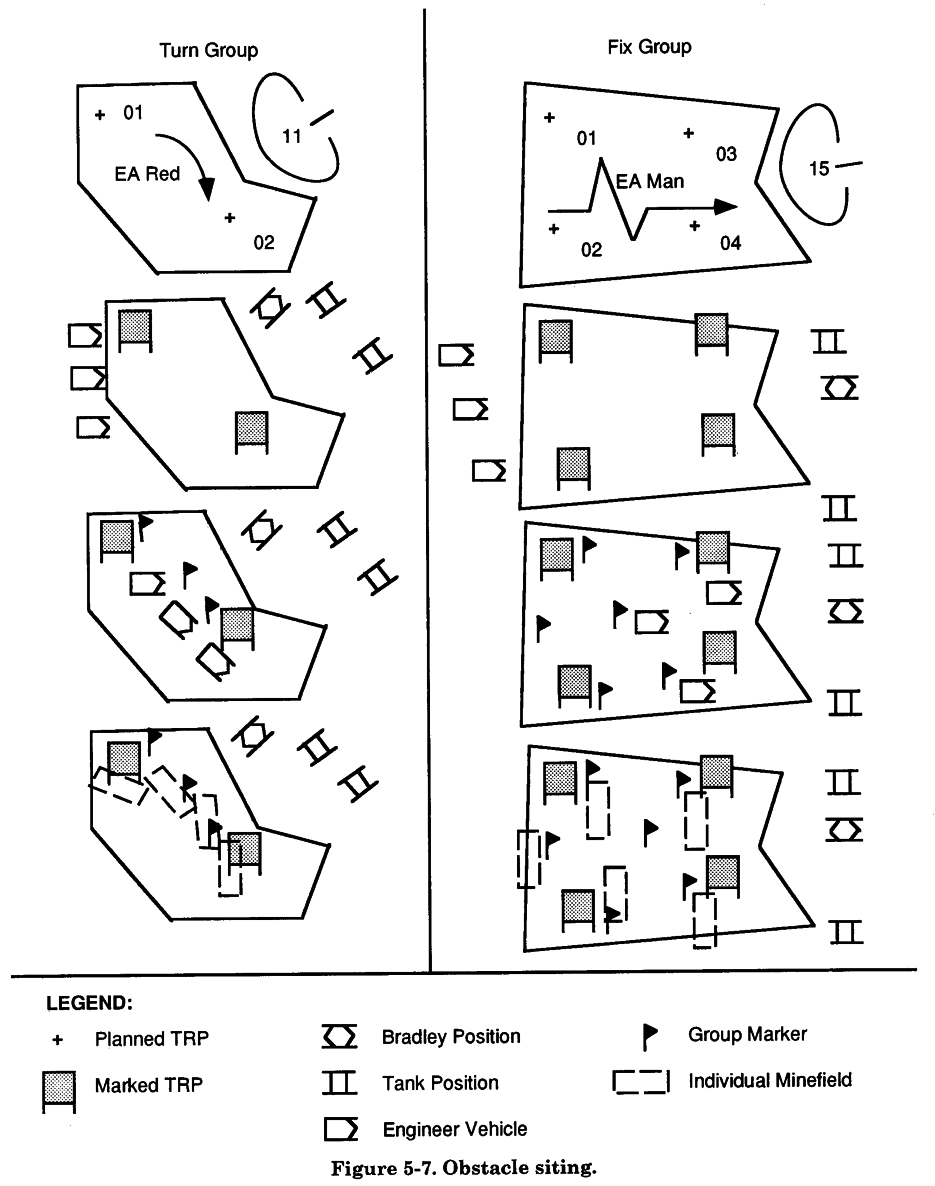
FM 90-7
Obstacle Planning at Task-Force Level and Below 5-15
FM 90-7
Chapter 6
Reserve
Obstacles
site. They also commit an engineer unit to
This chapter implements STANAG 2017.
provide the technical expertise to ensure
that the obstacle is executed. Both the
maneuver and engineer units that the com-
This chapter outlines the procedures to plan,
mander dedicates to the reserve obstacle
prepare, and execute reserve obstacle
have other potential missions. The com-
groups. Reserve obstacle groups are those for
mander must conclude that the reserve
which the commander restricts execution
obstacle group is so critical that the loss of
authority. These are "on-order" obstacles, units to protect and execute the obstacle
The commander specifies the unit responsi-
outweighs the combat potential of those
ble for obstacle emplacement, guarding, and
units in other areas.
execution. Units normally plan and prepare
The commander must clearly identify the
reserve obstacles during preparation of the
criteria for executing the obstacle. Reserve
battlefield. Units execute them only on com-
obstacles require detailed coordination and
mand of the authorizing commander or
synchronization to ensure success.
based on specific criteria that the com-
Units normally install, but do not execute,
mander identifies. The purpose of a reserve
reserve obstacles early in the preparation
obstacle group is to retain control over the
phase because they are a critical part of the
mobility along an AA. Commanders use
plan. Units may use a reserve obstacle to
reserve obstacles when failure to maintain
close a lane in a larger obstacle. Obstacles
control over the mobility along an AA will
used for rapid lane closure are often demoli-
have disastrous effects on the current battle
tion obstacles or mines; however, the type of
or future operations.
obstacle used is only limited by imagination
and ingenuity.
EMPLOYMENT PRINCIPLES
RESPONSIBILITIES
Commanders carefully select and have their
staffs plan reserve obstacles. Normally, the
Key persons involved in the execution of a
commanders assign a maneuver unit as a
reserve obstacle (see Figure 6-1, page 6-2)
guard element to protect the reserve obstacle
are the—
Reserve Obstacles 6-1

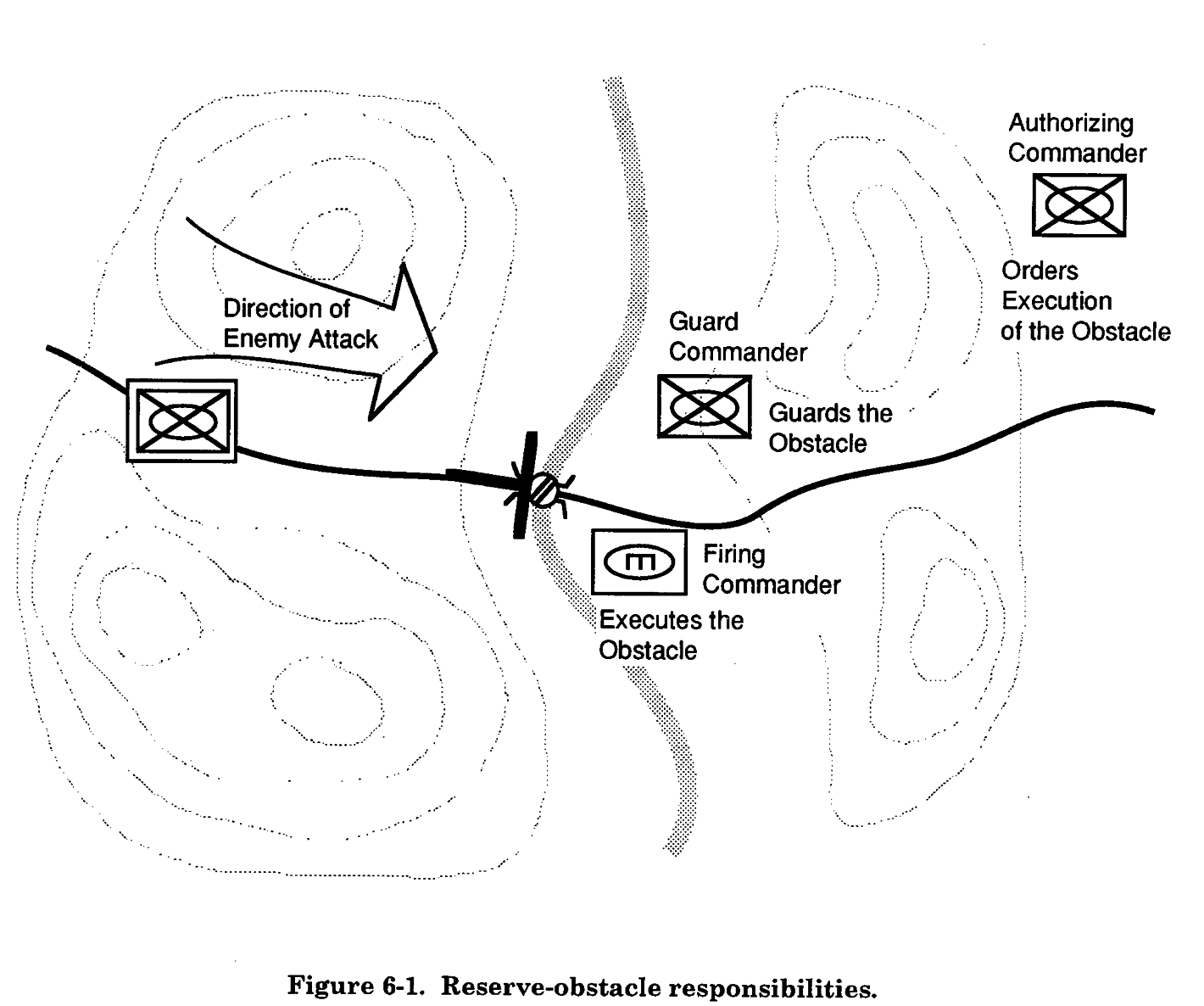


FM 90-7
Authorizing commander.
Selects the code words for the execu-
Guard commander.
tion of the obstacle.
Firing commander.
Establishes other specific criteria for
executing the obstacle if he does not
withhold the execution authority. He
AUTHORIZING COMMANDER
may authorize the guard commander
The authorizing commander is the maneu-
to execute the target based on his own
ver commander who determines the require-
initiative or based on other criteria.
ment for a reserve obstacle. The authorizing
Determines the need for a separate
commander—
guard force. If a small guard force can
protect the obstacle site, he may
Establishes the criteria and procedures
choose to combine the duties of the
for executing the obstacle. Typically, he
guard force and the firing party. In
withholds authority to execute until he
this case, the guard commander and
gives the order, using specific code
the firing commander are the same
words.
person.
6-2 Reserve Obstacles




FM 90-7
Determines the need for a separate fir-
The commander determines the require-
ing party. If the reserve obstacle
ment for a reserve obstacle during the
requires an engineer technical expert
COA analysis or possibly following the COA
on site to ensure obstacle execution,
development. The commander may also
then the firing party is separate
receive a requirement for a reserve obstacle
from the guard force.
from a higher commander as a specified
task. If so, the staff identifies the require-
GUARD COMMANDER
ment during the mission analysis.
The guard commander is the leader of the
If the commander decides that he needs to
unit that protects the obstacle. He is a
retain control over mobility along an AA, he
commissioned officer or an NCO. The guard
has two options. He can—
commander—
Assign a specified task to a subordinate
Ensures that the obstacle site is not
unit to maintain a lane.
captured by the enemy.
Use a reserve obstacle.
Gives the firing commander the order
to execute the obstacle (based on the
The commander must consider the effect of
criteria that the authorizing com-
the premature loss of mobility along an AA.
mander established).
For example, if an ACR is withdrawing
under pressure through a division sector,
premature loss of mobility along the AA may
FIRING COMMANDER
slow or even stop the ACR's withdrawal.
The firing commander is the leader of the
The corps commander may specifically task
firing party and is an engineer NCO, unless
the division commander to ensure that the
the commander determines that there is no
ACR’s withdrawal lanes are clear until the
need for an engineer technical expert on site.
ACR has withdrawn. Thus he allows the
The firing commander—
division commander to determine the need
Executes the obstacle when the guard
for reserve obstacles. The corps commander
commander orders him to do so.
may also decide to use reserve obstacles (see
Inspects and repairs the obstacle, as
Figure 6-3, page 6-6).
required.
If the commander decides to use reserve
The specific orders to the guard and firing
obstacles, he again has two options. If spe-
commanders are shown on the sample
cific obstacle sites are obvious, such as
STANAG Form 2017 (see Figure 6-2,
bridges across a major river, the corps com-
pages 6-4 and 6-5.
mander may designate those sites as corps
reserve obstacles. This will require detailed
RESERVE-OBSTACLE PLANNING
planning by the corps staff and coordination
down to the executing unit. If obstacle sites
CONSIDERATIONS
are not obvious, the corps commander may
The staff plans reserve obstacles during
specify that any obstacles along the with-
the decision-making process. The following
drawal lanes are corps reserve targets. This
paragraphs contain some considerations for
will require subordinate units to conduct
determining the requirement for, and the
detailed planning and then coordinate
planning, preparation, and execution of,
through operational and engineer channels
reserve obstacles.
with the corps.
Reserve Obstacles 6-3

FM 90-7
6-4 Reserve Obstacles
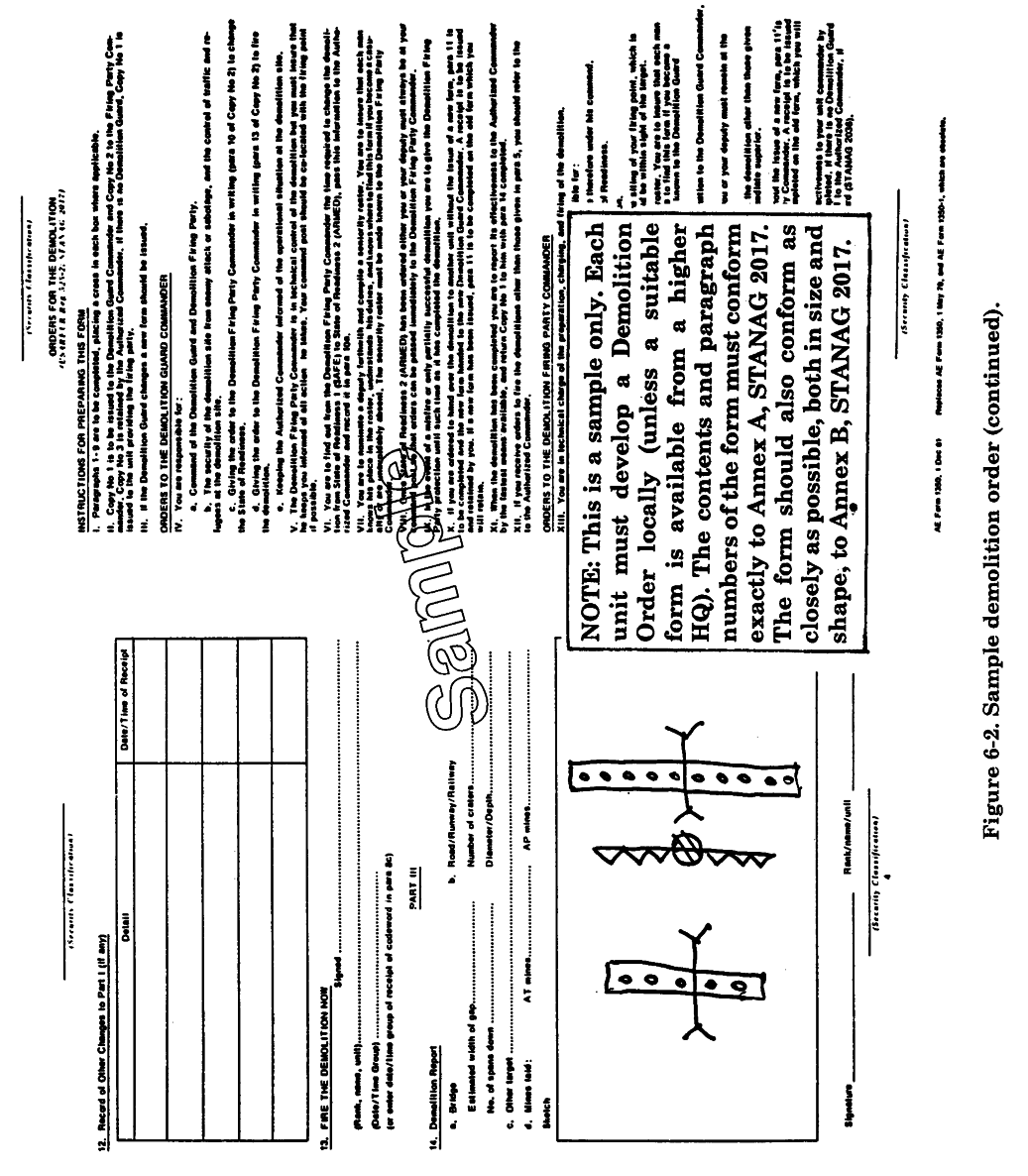
FM 90-7
Reserve Obstacles 6-5
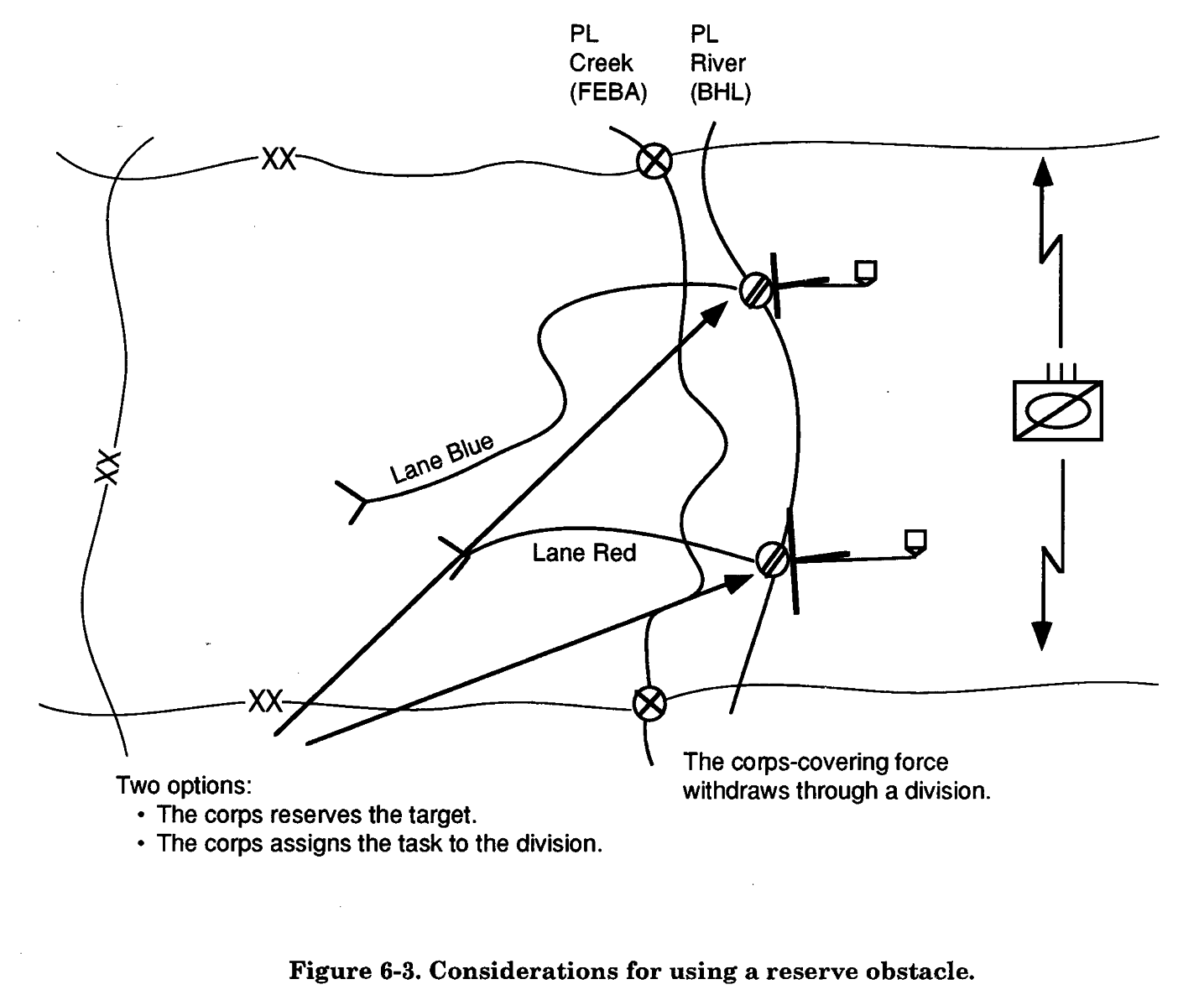

FM 90-7
The need for reserve obstacles is not limited
ADDITIONAL FACTS AND
to ensuring successful rearward passage of
ASSUMPTIONS
friendly units. The reserve obstacle may con-
Once the commander decides on the need for
trol key terrain along a CATK axis that is
a reserve obstacle, the staff examines the
along the most dangerous enemy AA (see
SITEMP. It is used to determine the–
Figure 6-4). Control of the key terrain (a Size of the guard force required.
choke point) along the CATK axis may be
Requirement to secure the obstacle,
critical to success in the battle. The com-
either by fire or occupation.
mander may reserve the obstacle controlling
Size of the obstacle required.
the key terrain to retain his flexibility to
commit the CATK force along the axis and
Most effective type of obstacle.
have a means to close the AA if the enemy
The expected threat determines the size
uses the most dangerous AA.
of the guard force. The enemy and terrain
6-6 Reserve Obstacles
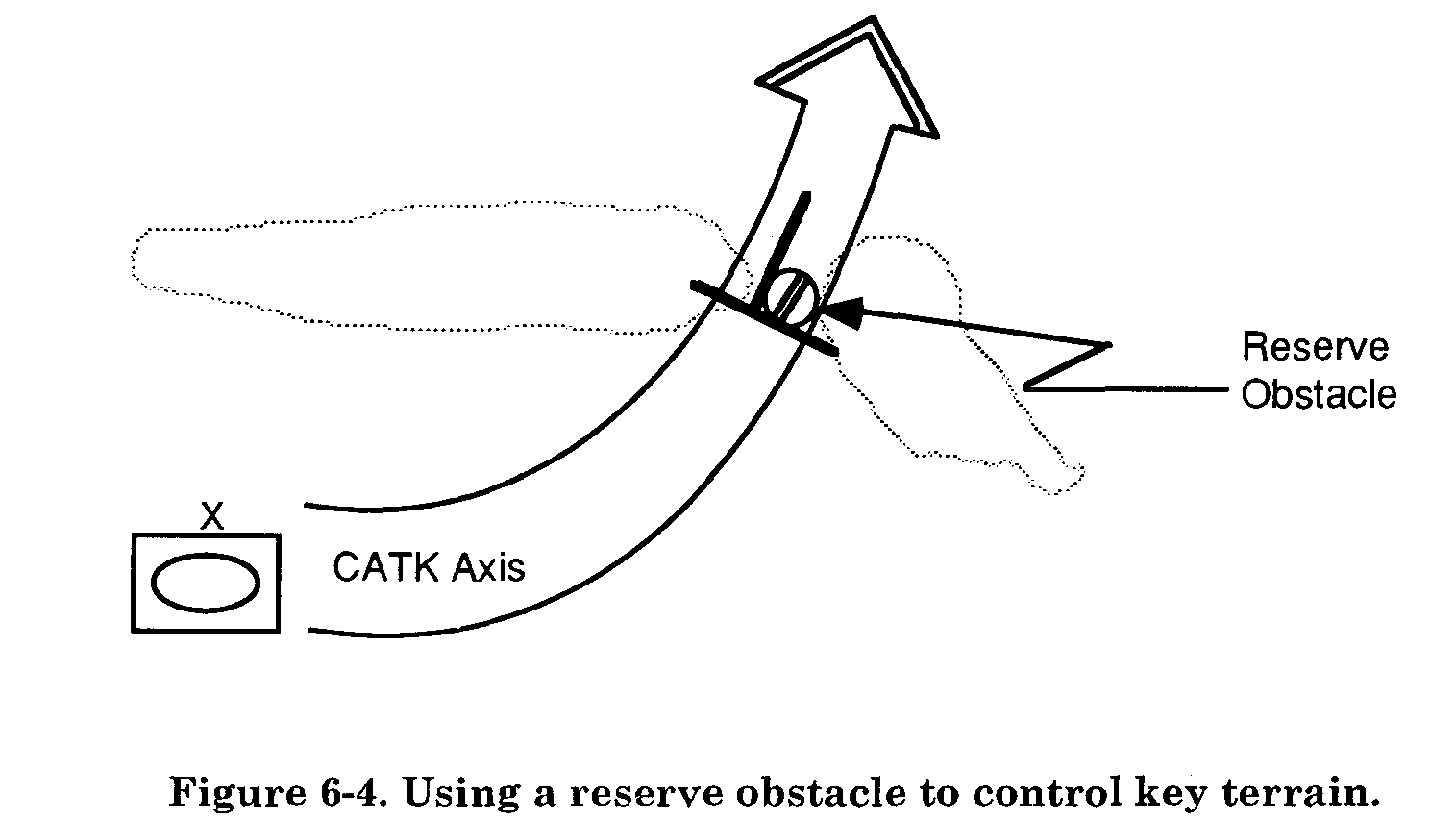

FM 90-7
situation dictate whether the guard force site is dictated by a higher commander or must secure the site by occupation or the terrain. A reserve obstacle directed by whether they can do so from a distance by the higher HQ may require the subordinate fire. The terrain that determines the size of unit to adjust its positions to cover the the AA may determine the size of the obsta- obstacle by fire. In some terrain, there may cle. The enemy’s breaching capability may be only a few sites where a commander can determine the most feasible obstacle. For use reserve obstacles to control mobility example, if the enemy does not have organic along an AA. This terrain is usually domi-assault bridging, then tank ditches and RCs nated by some type of existing obstacle (such may be the best obstacle.
as a river, canal, or canyon). If the com-
mander decides to use a reserve obstacle, he
repositions forces to ensure that the obstacle
FIRES ANALYSIS
is covered by fire.
The staff analyzes the COA to determine
the—
Location of the obstacle relative to sub-
OBSTACLE INTENT INTEGRATION
ordinate units’ positions.
The staff places the reserve obstacle group
Ability of the unit to cover the reserve relative to the terrain and friendly maneu-obstacle group by fire following execu- ver graphics to support the COA. Normally, tion.
the desired obstacle effect of a reserve obsta-
Most likely subordinate unit to assign to cle is to block. Even if it is used to close a the guard force mission.
lane in a directed fix obstacle group, the
The best spot for an obstacle may not be the commander uses the reserve obstacle to best spot to bring overwhelming combat block the AA, in this case the lane; however, power to bear. When the unit uses the the commander may use reserve obstacles to reserve obstacle to close a lane in a properly achieve any of the four obstacle effects. The planned directed obstacle, the reserve
staff indicates the location of reserve obsta-
obstacle is already integrated with fires.
cles by using the obstacle effect graphics and
However, in some cases, a reserve obstacle annotating them as reserve obstacles.
Reserve Obstacles 6-7



FM 90-7
OBSTACLE PRIORITIES
required time. The obstacle-emplacement
Reserve obstacles are high-priority obsta-
unit is dedicated to the reserve obstacle,
cles. Because a reserve obstacle is critical to
which makes it an "on-order" mission. The the plan, units must emplace reserve obsta-staff identifies potential situations where
cles early in the preparation phase.
SCATMINE assets may not be available and
ensures that the commander understands
any risk associated with their nonavailabil-
MOBILITY REQUIREMENTS
ity.
The commander’s decision to use reserve
obstacles is based on—
DECISION AND EXECUTION
Analysis of the COA.
The staff prepares orders and provides
Detection of mobility requirements.
mation on reserve obstacles on the SCI
An additional consideration is the establish-
of-obstacles overlay, in a reserve-obstacle-
ment of procedures for traffic control and
execution matrix, and in a demolition order
lane marking. Figure 6-5 shows a possible for the unit with the guard force mission.
lane-marking system based on lane-marking
guidance from FM 90-13-1.
SCHEME-OF-OBSTACLES OVERLAY
After the commander decides on a COA, the
Reserve obstacles are included on the
staff can do the detailed planning for reserve
scheme-of-obstacles overlay. The staff uses
obstacles. This detailed planning involves
the obstacle effects graphics and, in many
designing and resourcing the r











































